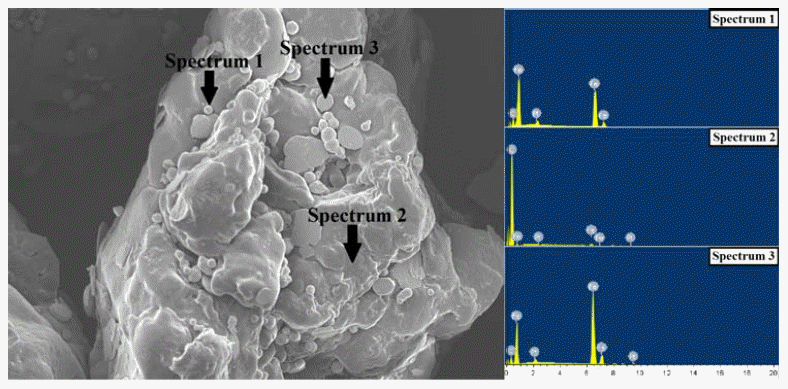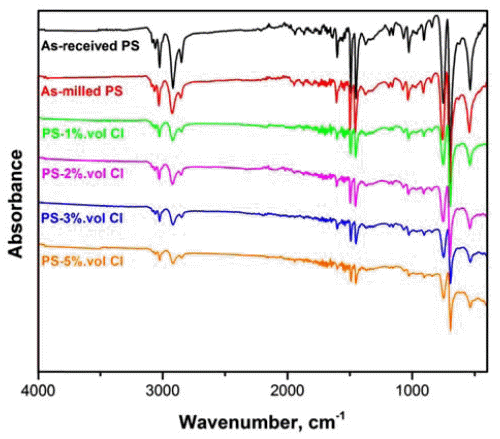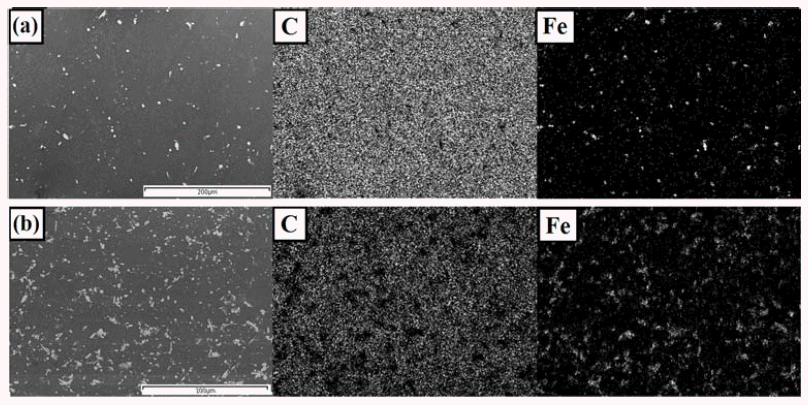Articles
- Page Path
- HOME > J Korean Powder Metall Inst > Volume 23(4); 2016 > Article
-
Article
- Synthesis of Carbonyl Iron-reinforced Polystyrene by High Energy Ball Milling
- Hong-Hai Nguyen, Minh-Thuyet Nguyen, Won Joo Kim, Jin-Chun Kim*, Young-Soo Kima, Young-Hyuk Kima, Olga B. Nazarenkob
-
Journal of Korean Powder Metallurgy Institute 2016;23(4):276-281.
DOI: https://doi.org/10.4150/KPMI.2016.23.4.276
Published online: July 31, 2016
School of Materials Science and Engineering, University of Ulsan, 93 Daehak-ro, Nam-gu, Ulsan, 44610, Korea
a R&D Center, BnK Co., Ltd, #311, Technopark, 421, Daun-Dong, Ulsan, Korea
b Tomsk Polytechnic University, Lenin str. 30, 634050, Tomsk, Russia
- * Corresponding Author: Jin-Chun Kim, TEL: +82-52-259-2231, FAX: +82-52-259-1688, E-mail: jckimpml@ulsan.ac.kr
• Received: May 13, 2016 • Revised: August 3, 2016 • Accepted: August 9, 2016
© The Korean Powder Metallurgy Institute. All rights reserved.
- 911 Views
- 5 Download
- 1 Crossref
Abstract
- Carbonyl iron (CI) is successfully incorporated as an additive into a polystyrene (PS) matrix via a highenergy ball milling method, under an n-hexane medium with volume fractions between 1% and 5% for electromagnetic interference shielding applications by the combination of magnetic CI and an insulating PS matrix. The morphology and the dispersion of CI are investigated by field emission scanning electron microscopy, which indicates a uniform distribution of CI in the PS matrix after 2 h of milling. The thermal behavior results indicate no significant degradation of the PS when there is a slight increase in the onset temperature with the addition of CI powder, when compared to the as-received PS pellet. After milling, there are no interactions between the CI and the PS matrix, as confirmed by Fourier transformed infrared spectroscopy. In this study, the milled CI-PS powder is extruded to make filaments, and can have potential applications in the 3-D printing industry.
- Polymer matrix composites reinforced with metal particles have been known as a type of materials possessing the properties of both metals and polymers such as good fabricability, high corrosion resistance, and low density for widely industrial applications (electromagnetic shielding, electrical heating, discharging static electricity, and heat conduction) [1-5]. Polystyrene (PS) has been known as a versatile plastic used to make a wide variety of consumer products due to its non-toxicity, ease of manufacture, light weight, low cost, superior perform in term of water absorption and dielectric strength [6-8]. When combined with fillers and additives (such as metals or ceramics), PS becomes a potential applicant for making electronic devices, automobile parts and even applying in construction and 3D printing [9-11]. Carbonyl iron (CI) is a wellknown elemental iron with small particle size. Its toxicity has been investigated to be quite low [12], which is an essential property for filled in polymer matrix [13,14]. Moreover, carbonyl iron can be used as magnetic cores with high permeability and saturation magnetization, therefore, carbonyl iron coated or reinforced in polymer matrix to form core-shell structure for electromagnetic shielding applications. Several techniques have been used to produce iron-PS such as ultrasound radiation, solvent casting, magnetorheological fluid, and anionic polymerization [13,15,16]. However, CI-PS composite powders fabricated by mechanical milling route were still not investigated due to having high flexibility and weldability, which lead to the adhesion of polystyrene.
- High energy ball milling (HEBM) which is called as a solid state method is used to synthesize not only alloys, intermetallic compounds, ceramic and inorganic composites, but also metal-organic materials [17,18]. Because of high energy process leading to increase temperature during milling, HEBM has some limitations to synthesize metal-polymer composites due to polymers having low glass transition and melting temperatures as well as flexibility. To avoid the above problems, in this study, n-Hexane was used as an unreactive and anti-adhesive solution. P. Raju and S. R. Murthy recently used mechanical milling process for fabricating ferrite magnetic particles reinforced in insulating polymer, relying on that the insulating properties of magnetic particles could be improved. Therefore, CI in this study was considered as a magnetic particle material for reinforcing in insulating PS matrix for electromagnetic interference shielding.
- The aim of this paper is to investigate the reinforcement of carbonyl iron in PS matrix at different volume fractions. The change of thermal property and degradation of PS during mechanical milling was also examined. The synthesized powders were extruded to confirm the possibility of filament making for future 3D printing.
1. Introduction
- 2.1. Materials
- Polystyrene pellets supplied by Sigma Aldrich (CAS 9003-53-6) with properties such as density=1.047 g·cm-3, molecular weight - Mw ~ 280,000 with the dimensions of about 3 mm × 2.5 mm × 1.5 mm were used in this study. Carbonyl iron, CI (density of 7.86 g·cm-3, assay of 97% Fe basis) was supplied by Sigma Aldrich (CAS 7439-89- 6) with the particle size under 3 μm in spherical shape, which was used as an inorganic additive for metal-polymer composite making.
- 2.2. Synthesis of CI/PS composite powders and samples
- CI powders and PS pellets were weighted and mixed following the compositions of PS-100%, PS-1vol% CI, PS-2vol% CI, PS-3vol% CI and PS-5vol% CI. 10 g of the mixture was filled into a stainless still vial with an inner diameter of 50 mm. 40 ml of n-Hexane seen as a process control agent was added to avoid the agglomeration and adhesion. The hardened steel balls (6 mm in diameter) were used with the balls to powder ratio of 10:1. The vial was then placed in a processing chamber of a high energy ball mill (Spex mill). The process was set up with the schedule of running for 10 minutes and stopping for 10 minutes to ensure that the temperature of the milling process does not exceed 50°C. The milling was carried out in 2 hours of operating. After mechanically milling, the powders were hot pressed (HP) at 150°C and 30 MPa for 1 hour into cylindrical sample to investigate the homogeneity of CI in PS matrix. The mechanically milled powders of PS, PS-1vol% CI and PS-5vol% CI were also extruded by using an extrusion machine. The machine was self-made with a head containing an extrusion hole (the diameter of 1.70 mm) to investigate the possibility of filament making of materials. The head was heated to reach the starting melting point of materials around 270°C, then the filament was extruded and cooled by wind fan system. The as-extruded filament diameter was 1.75 mm.
- 2.3. Characterizations
- The morphology of milled powders was performed by field emission scanning electron microscopy (FESEM) with energy-dispersive spectroscopy (EDS) detector. Thermal behavior of as-received PS pellet and milled powders were investigated by thermogravimetric analysis (TGA) at the heating speed of 10°C/min under nitrogen atmosphere. Structural characterization was performed by Fourier transformed infrared spectroscopy (FTIR) using a FT-IR spectrum. The spectra were recorded at a constant temperature from 400 to 4000 cm-1.
2. Experimental Procedure
- Fig. 1 shows the morphology of carbonyl-polystyrene (CI-PS) at different volume fraction of CI added into PS. Generally, after milling, the shape of the powders has been altered compared to as-received PS pellets. By the effect of fracture mechanism, the pellets were broken down into small particles. Moreover, PS are flexible, therefore, it trended to aggregate and stick together or even melt under high mechanical energy. However, all milling mechanisms was cooled by stop periods and controlled by nhexane solution leading to the fracture mechanism was dominant, followed by the reducing of particle size. Although the addition of various volume fractions of CI, the particles shape and size were almost similar. With 1vol% of CI added in PS, the CI distribution in PS is not uniform due to low CI amount (Fig. 1(b)). Nevertheless, the uniform distribution of CI in PS matrix was clearly observed with the addition of at least 2vol% CI. Because of the high energy force, CI powders were flatted and distributed uniformly in the PS surface as seen in Fig. 1(f). The EDS analysis was taken place to confirm the chemical compositions, which is indicated in Fig. 2. Both CI and PS were analyzed and their existence was identified.
- SEM elemental mapping images of the materials under studying are shown in Fig. 3. The mapping images of carbon and iron elements again confirm the distribution of CI in PS which shows that, at the addition of 1vol% CI, the extraordinary dispersion of CI in composite particles was clearly observed (Fig. 3(a)). At the other added CI amount of composites, CI is generally uniformly distributed in PS matrix.
- Fig. 4 presents the thermogravimetric curves of PS and CI-PS materials at different amounts of CI. Generally, there are no difference in their themodegradation behavior of the PS is observed compared to as-received PS pellet. The onset temperature of decomposition was slightly shifted towards with little higher temperatures. However, in this study, as-received PS is big pelleted form, therefore, it takes time to transfer heat to the center of pellet leading to the onset of this PS having highest temperature. In the another hand, milled PS and CI-PS composites are powder type, consequently, the onset temperatures still increased slightly with the enhancing of CI amount. The value of the residue was equal with weight percent of CI in the PS matrix after decomposition.
- Fourier transformed infrared spectra of PS and CI-PS composites are shown in Fig. 5. The FTIR for all samples were observed with no significant differences. The main absorption bands of PS are presented at 3024-CH ring stretching, 2917-CH2 symmetric and asymmetric chain stretching, 1492-CC ring stretching, 1450-CH2 chain ending, 1027-CH2 ring plane, 749-CH out of plane and 695- CH out of plane in cm-1. By the effect of high energy ball milling, PS absorbance intensities of milled PS and CI-PS powder has lower value than compared to as-received PS pellet as a result of PS circuit breaking leading to a decreasing in molecular weight, Mw. However, the main absorption bands of PS was not significant altered, which is an evidence for confirming the fact that no significant interactions between PS and CI powders.
- After mechanically milling, the CI-PS composites with the CI volume fractions of 1 and 5% were hot pressed at 150°C to make the compact samples. Fig. 6 shows the elemental mapping of CI-PS HP samples. With added a small amount of CI (1 vol%), the sample was observed with an extraordinary dispersion (Fig. 6(a)). Inversely, the sample with 5vol% of CI expresses a uniform distribution of CI in PS matrix.
- The filaments with 1.70 mm in diameter were obtained, which was displayed in Fig. 7. However, due to the difference in thermal conductivity of CI and PS and air working processing, the filament partly contained air holes in some parts (unstable processing). The machine was used for only investigating the possibility of filament making, therefore, to avoid that problem, the process was recommend to perform in a vacuum medium or use lower temperature types of extrusion machines. This result was released to give a potential applicant for 3D filament printing industry.
3. Results and Discussion
Fig. 1

The FESEM images of the 2h milled CI-PS powders with the addition of (a) 0%, (b) 1%, (c) 2%, (d) 3%, (e) and (f) 5% at different magnification in volume fractions.

Fig. 3

The mapping images of iron and carbon elements of milled powders with the addition of (a) 1%, (b) 2%, (c) 3% and 5% in volume fractions.

Fig. 6

The mapping images of iron and carbon elements of the hot pressed samples with the CI volume fraction of (a) 1% and (b) 5%.

- CI-PS composites were successfully synthesized by high energy ball milling under n-Hexane medium. The CI particles were uniformly distributed in polystyrene matrix for the addition of at least 2vol% CI. The thermogravimetric result indicates a slight difference in onset temperatures with no degradation compared to as-received PS pellet in term of thermal behavior. There are no significant interactions between PS and CI powders with the decreasing in molecular weight by the effect of high mechanical energy and the amount of CI additive.
4. Conclusions
-
Acknowledgements
- This work (S2184829, 2015) was financially supported by the Small and Medium Business Administration, Korea
Acknowledgement
- 1. K. Zhu and S. Schmauder: Comp. Mater. Sci., 28 (2003) 743. .Article
- 2. M. Rusu, N. M. Sofian and D. Rusu: Polym. Test., 20 (2001) 409. .Article
- 3. N. M. Sofian, M. Rusu, R. Neagu and E. Neagu: J. Thermoplast. Compos. Mater., 14 (2001) 20. .Article
- 4. I. Krupa and I. Chodak: Eur. Polym. J., 37 (2001) 2159. .Article
- 5. A. T. Ponomarenko, V. G. Schevchenko and N. S. Enykolopyan: Adv. Polym. Sci., 96 (1990) 125. .Article
- 6. J. T. Cohen, G. Carlson, G. Charnley, D. Coggon, E. Delzell, J. D. Graham, H. Greim, D. Krewski, M. Medinsky, R. Monson, D. Paustenbach, B. Petersen, S. Rappaport, L. Rhomberg, P. B. Ryan and K. Thompson: Toxicol. Environ. Chem., 5 (2002) 1. .ArticlePubMed
- 7. M. Mihai, M. A. Huneault and B. D. Favis: J. Cell. Plast., 43 (2007) 215. .Article
- 8. D. Prime, S. Paul and P. W. Josephs-Franks: IEEE T. Dielect. El. In., 15 (2008) 905. .Article
- 9. S. Doroudiani and M. T. Kortschot: J. Thermoplast. Compos., 17 (2004) 13. .Article
- 10. D. Prime, S. Paul and P. W. Josephs-Frank: Philos. T. Roy. Soc. A., 367 (2009) 4215. .ArticlePubMed
- 11. F. Rengier, A. Mehndiratta, H. V. Tengg-Kobligk, C. M. Zechmann, R. Unterhinninghofen, H. U. Kauczor and F. L. Giesel: Int. J. Comput. Assist. Radiol. Surg., 5 (2010) 335. .ArticlePubMed
- 12. P. Whittaker, S. F. Ali and V. C Dunkel: Regul. Toxical. Pharm., 36 (2002) 280. .ArticlePubMed
- 13. J. L. Arias, V. Gallardo, F. Linares-Molinero and A. V. Delgado: J. Colloid Interf. Sci., 299 (2006) 599. .ArticlePubMed
- 14. M. Tasdemir and H. O. Gulsoy: Polym-Plast. Technol., 45 (2006) 1207. .Article
- 15. S. Wizel, S. Margel and A. Gedanken: Polym. Int., 49 (2000) 445. .Article
- 16. M. A. Lee, F. F. Fang and H. J. Choi: Phys. Status. Solidi A., 204 (2007) 4186. .Article
- 17. C. Suryanarayana: Prog. Mater. Sci., 46 (2001) 1. .Article
- 18. D. Olmos, J. M. Martinez-Tarifa, G. Gonzalez-Gaitano and J. Gonzalez-Benito: Polym. Test., 31 (2012) 1121..Article
Figure & Data
References
Citations
Citations to this article as recorded by 

- Progress toward sustainable polymer technologies with ball-mill grinding
Antonio Rizzo, Gregory I. Peterson
Progress in Polymer Science.2024; 159: 101900. CrossRef
Synthesis of Carbonyl Iron-reinforced Polystyrene by High Energy Ball Milling
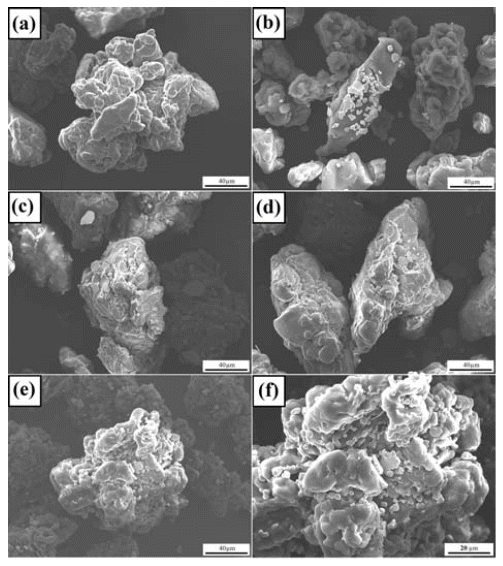

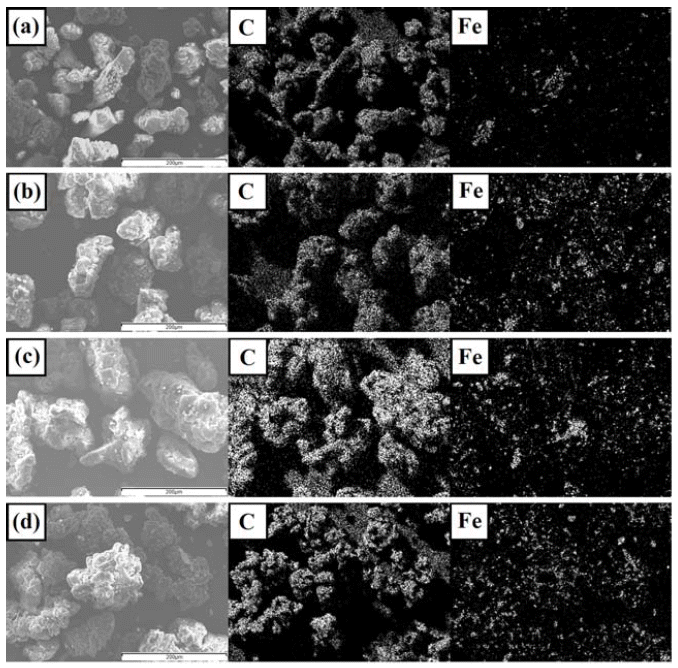
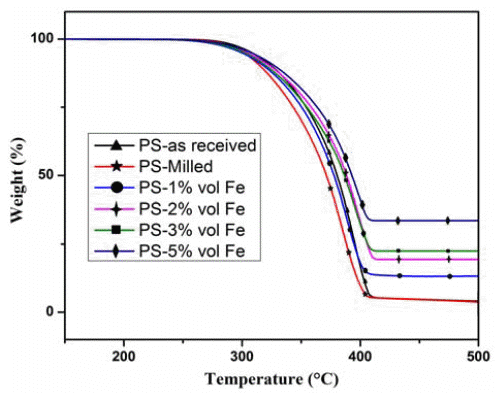



Fig. 1
The FESEM images of the 2h milled CI-PS powders with the addition of (a) 0%, (b) 1%, (c) 2%, (d) 3%, (e) and (f) 5% at different magnification in volume fractions.
Fig. 2
The EDS spectrums of selected components of milled PS-5vol% CI.
Fig. 3
The mapping images of iron and carbon elements of milled powders with the addition of (a) 1%, (b) 2%, (c) 3% and 5% in volume fractions.
Fig. 4
TGA thermodiagrams of PS and CI-PS composites.
Fig. 5
FTIR spectra of all the samples under study.
Fig. 6
The mapping images of iron and carbon elements of the hot pressed samples with the CI volume fraction of (a) 1% and (b) 5%.
Fig. 7
The filaments and powders of PS-CI composites.
Fig. 1
Fig. 2
Fig. 3
Fig. 4
Fig. 5
Fig. 6
Fig. 7
Synthesis of Carbonyl Iron-reinforced Polystyrene by High Energy Ball Milling
TOP
 KPMI
KPMI





 Cite this Article
Cite this Article
